 | | SPONSORED |
| When the blossom on forsythia is swelling, it’s time to think about lawn care. A basic spring weed treatment is the very minimum. Addressing weeds before they emerge is the key to a good lawn season. Here the 10 most common lawn care problems—focusing first on yellow nutsedge and crabgrass since both need early attention.
|
|  | 10 COMMON LAWN PROBLEMS AND SOLUTIONS
Let’s start with lawn weeds. There are three main types of weeds: grassy weeds (e.g., crabgrass), sedge weeds (e.g., yellow nutsedge), and broadleaf weeds (e.g., dandelions). Some weeds are perennials (coming back year after year), while other weeds are annuals (dying within 12 months).
1. YELLOW NUTSEDGE
Problem: Yellow nutsedge (Cyperus esculentus) is a troublesome weed which competes with lawn grass within 2 weeks of emergence in spring—and it continues to compete for light and nutrients all summer long. It’s important to recognize that this weed is neither a grass nor a broadleaf weed. It is a “sedge,” so it can not be controlled or treated like crabgrass or dandelions.
(Not only is yellow nutsedge problematic in lawns, but also it can limit vegetable crop production to zero; if it goes uncontrolled, there will be a total loss of crop.)
Identification: It’s not easy for the regular homeowner to identify yellow nutsedge. A “sedge” has a triangle-shape stem (i.e., not round, like grass), which you can feel if you roll the base of the plant between your fingers. It has a brighter, shinier, green-yellow color, and its stems are more erect than those of lawn grass. Sedge also grows faster than many lawn grasses, so you’ll notice it when it outgrows your turf. Yellow nutsedge produces a golden seedhead but reproduces primarily by underground tubers (which can remain dormant in the ground for several years). |  | | Image: Yellow nutsedge is a perennial “grasslike” weed that plagues many lawns. Although it looks like a grass, it is actually a sedge. Credit: S. Patil/Shutterstock. | Solution: You can try pulling out the sedge when it is young. However, the underground tubers will just regrow. Dormant tubers can survive in the soil for up to 3 years. It could take years to eradicate nutsedge.
The only solution for a large patch of yellow nutsedge in your lawn is to apply effective selective herbicides. The traditional herbicides used to control dandelions (Taraxacum officinale) and crabgrass (Digitaria spp.) are ineffective. Timing is very important. Treat beginning in the spring, before the weed begins producing new tubers, which occurs in summer through fall. Do not wait until the fall as you would with broadleaf weeds. Usually, two or three applications about 4 to 7 days apart are required to kill existing patches of nutsedge. Be patient. If tubers have grown, 2 to 3 years of control using herbicides may be needed. But this will work. Always read the label before applying any herbicide on any crop.
2. CRABGRASS
Problem: Crabgrass, the weed everyone loves to hate, is a grassy weed and an annual. It survives anywhere and will happily push out other grasses over time. |
|
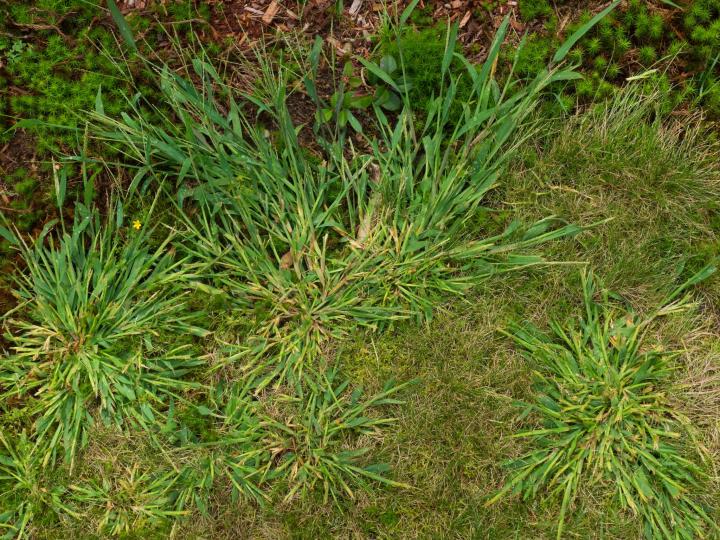 | | Image: Common crabgrass weeds in the garden. Credit: Christian Delbert. | Solutions: Crabgrass thrives in compacted lawns and clay soil. Aerate your soil (see #4 below). Too much nitrogen fertilizer encourages crabgrass. Avoid lawn fertilizers that say “quick green-up” on the label. Select a fertilizer product with half of its nitrogen in a slow-release form. For a 1,000-sq.-ft. lawn, use less than 3 lbs. of nitrogen annually.
Apply a pre-emergent herbicide (i.e., before the crabgrass seed sprouts). Here are two options:
- Corn gluten meal, a relatively new and increasingly popular natural pre-emergent herbicide, appears to be successful at preventing crabgrass and other common weeds. A by-product of milling corn, it is completely benign. However, you need to apply corn gluten meal for several years to reach full effectiveness. A three-year systematic application can yield a nearly weed-free lawn. Research at Iowa State University showed that 60 percent of weeds are eliminated the first year, 80 percent the second, and 90 to 100 percent the third year of corn gluten meal application. Some companies sell a pelletized form containing potash and nitrogen, but you may have to search a bit or ask your retailers to stock it.
- A traditional (chemical) pre-herbicide may be applied in early spring if crabgrass is persistant. Many fertilizers have crabgrass preventers added. The timing of application is critical because the window is short (about 10 days). The temperature should hit 52 degrees F. (You can also buy an inexpensive soil thermometer from a garden center.) Often, this happens after your second mowing. Ideally, apply just before it rains. Otherwise, water it in. Unfortunately, if you treat your lawn with a pre-emergent, you cannot seed turfgrass or you simply kill your lawn grass as well. Seed turfgrass in late summer or early fall with about 8 weeks gap in between the two chores. Once crabgrass emerges, preemergence herbicides have no effect.
Post-emergence, there are several options. When the plants are very young and small, the easiest solution is to pull them out. Don’t even try to pull large crabgrass; you’ll just create a big hole and encourage the seed heads to cultivate new crabgrass.
- A natural post-emergent herbicide is vinegar (in a higher concentration than regular grocery store vinegar). However, it’s nonselective. So, make spot applictions directly onto the leaves of the weed plant or your lawn grass will be harmed. Note that vinegar spray kills only the leaves but does not travel to the root system; it will kill young newly germinated weeds and some annuals but will not work on established weeds.
- A traditional post-emergent herbicide can be applied when crabgrass is small. Spray postemergence herbicide directly on crabgrass after it has sprouted. If crabgrass grows large, it will be hard to kill. As crabgrass is an annual, it’s best to just tolerate it after mid-August; the herbicide won’t be effective and it will die with the first hard frost. Then plan to use a pre-emergent herbicide next spring.
Re-seed bare and thin spots in the fall; crabgrass is a summer annual. Perennial rye grass is the best competition for crabgrass. It also provides some insect control, as it emits a natural poison that gives some small, damaging bugs the “flu.”
Note: There are also grassy weeds which are perennials (example, nimblewill, quackgrass creeping bentgrass). You can not control perennial grassy weeds in perenially grassy lawns without killing lawn grass. In this case, getting rid of the weeds in the area and reseeding is the only solution. | 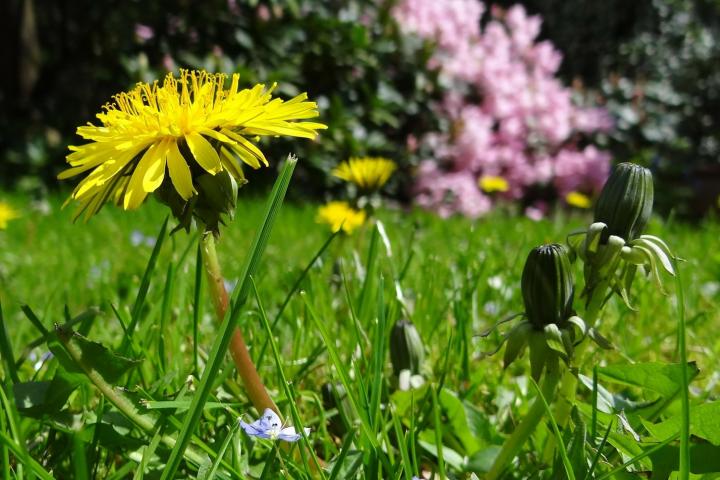 | 3. DANDELION
The dandelion is a broadleaf weed and a perennial. A thick, healthy lawn is again the best defense against dandelions, as it is for other common broadleaf lawn weeds (which include broadleaf plantain, ground ivy, mouseear chickweed, wild violet, and white clover).
Problem: Your neighbors may not stand for a full dandelion yard, but consider this: Dandelions are one of bees’ first springtime food sources, make a great wine, are a natural diuretic, can be dried and made into coffee, and can be braided into lovely necklaces. You can eat their young leaves in salads, and in fact, they were brought to this land as an exotic green. They’re an excellent source of potassium, phosphorus, calcium, and vitamin A. That said, dandelions are true survivalists, which makes them a pervasive inhabitant of lawns, gardens, and sidewalks everywhere.
Solutions: Not convinced and still want to get rid of your dandelions? Get a weeding fork. There’s a useful garden tool fittingly called a “dandelion digger” which is used for digging weeds with long taproots. It’s a solid metal rod (10 to 14 inches) long with a handle and two-pronged blade. Dandelions have a two-year life cycle. So, when they’re in the first year and appear as basal foliage, dig them out with a vengeance. It’s great exercise. If you miss some and they flower the next year, dig them out before they reach the seed (white puffy) stage. If you let them go to seed and spread their progeny, you’ll have to start the process all over again.
If you use traditional herbicides for dandelions and other perennial broadleaf weeds, use a selective “post-emergence” herbicide that controls broadleaf plants without damaging established grasses. Applying in the fall. The herbicide moves to the roots to kill the plant. Applying broadleaf herbicides in the fall will also kill winter annuals because they begin growth in autumn. Summer annuals (example, prostrate spurge) can be a problem and are best dug up by hand when young. | 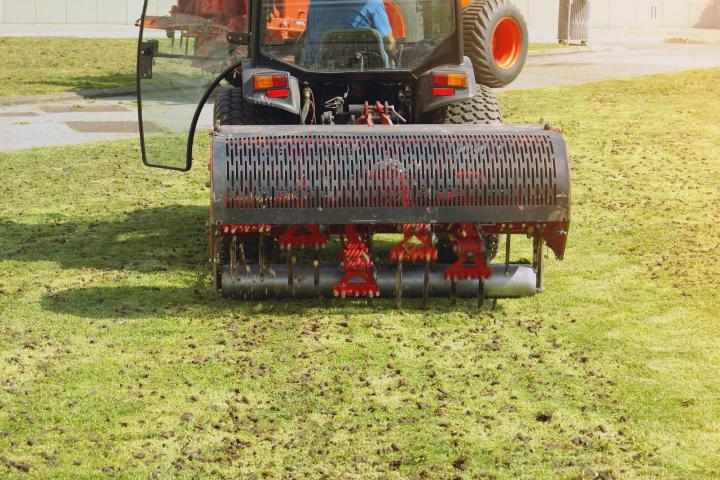 | Image: This is a large lawn aerator. Notice the “plugs.” You can rent regular push aerators from home improvement stores.
Credit: T.Sriwannawit/Shutterstock | 4. COMPACTED SOIL AND IMPROPER AERATION
Weeds thrive in compacted soil and soil that contains a lot of clay. Every other year, rent and run an aerator over the lawn to give the grass roots the air and water circulation they need. Aerification is the process of removing small columns of soil (called plugs) to reduce compaction. You want an aerifier that has tines that penetrate 2 to 3 inches into the soil and, ideally, have reciprocating arms to make more holes per square feet.
Only aerate a lawn when the grass is growing (spring through fall). After you aerate, your lawn will be covered with the little columns of soil. It doesn’t look great, but you can mow the plugs after they dry in order to break them up. They will break down and move back into the soil.
Problem: Improper aeration, often caused by a build up of thatch and compacted soil, can affect the health of your lawn over time by providing ideal conditions for disease.
Solutions: Healthy soil should be 50% solid, 25% water, and 25% air. To achieve this ideal, improve overall lawn health, and help prevent fungal diseases, you can rent “plug” machines that take out chunks of soil and redeposit them on your lawn.
Some catalogs sell aerating sandals with long-spiked soles. Gardeners are meant to strap these scary-looking things to their feet and walk around on the lawn. Users claim, however, that they take far too much weight and leg strength to be effective. In general, tools that spike or slice into the soil do little to relieve compaction issues. | 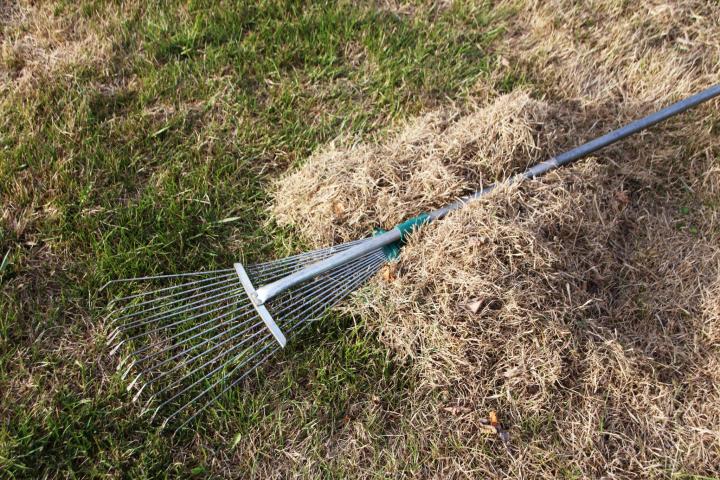 | | Credit: photowind/Shutterstock | 5. THATCH AND BROWN PATCHES
Problem: Thatch is actually a tightly intermingled layer of dead and decaying vegetation—an unhealthy build-up of organic matter that can cause brown patches in a lawn—indicating a pH imbalance. You may notice a “spongy” feeling when you walk across the lawn. Thatch is actually more common in lawns that receive a lot of maintenance than in lawns receiving less care. Thatch is a problem especially in lawns previously treated with chemicals where the grass’s natural ability to decay has been destroyed. Dry thatch repels water, while wet thatch invites fungal diseases.
Solutions: The best control is raising the lawn soil’s pH level. One way to do this is to rent a power rake, also called a dethatching machine (inquire at your garden supply center), which uses rigid wire tines or steel blades that slice through the thatch to the soil surface, tearing and pulling up the thatch. The best time to de-thatch is in late spring. Don’t do it during midsummer, when the lawn may be stressed, or when the lawn is wet. Hand raking is less harsh but can be impractical and back-breaking work for large lawns. Molasses diluted with hot water and sprayed on the lawn can help stimulate natural organisms to eat the thatch layer.
Dethatching with a power rake can be very destructive. Because of this, it may be best to aerate lawns that have thick thatch layers.
Aerification can help reduce thatch that is more than ¾ thick. Aerate the lawn annually and reduce your water and fertilization rates to reduce thatch buildup. |  | | Image: The larva of a chafer beetle. Credit: Stephen Farhall/Shutterstock. | 6. WHITE GRUBS AND INSECTS
Problem: If your lawn turns brown in early fall and raccoons and skunks begin to dig up your lawn, you may have white grubs, which are the immature stage of Japanese beetles and chafer beetles.
Grubs cause lawns to turn yellow and die, but are fairly easily controlled through nonpoisonous means. First, pull up the dead grass and make sure you really do have grubs, which are white, C-shaped, and very easy to see against dark soil.
Solutions: Insecticides or pesticides are hardly ever necessary to control the most common lawn pests, and the same is true for white grubs. According to studies, 70% of pesticide applications to control white grubs are unnecessary.
Pull up the grass, which may almost roll up like a carpet. If you see less than 15 grubs per square foot, don’t do anything; lawns can tolerate it. Be sure to water grass during dry spells and fertilize in autumn. If more grubs are found, apply a quick-acting insecticide.
But if grubs are found in October or later or spring, do not use insecticide. The grubs are so large they are not easily killed.
Two biological controls for grubs are beneficial nematodes and milky spore disease. These will not harm people or pets.
- Milky spore disease is a bacterium that controls chewing insects, including beetles, and can be purchased under several brand names. You cannot use chemical grub control while using milky spore. It takes several years to become effective but, once established, it lasts up to 20 years. Buy it at your local garden center; follow the directions to the letter.
- A better biological control is to use beneficial nematodes (insect-parasitic nematodes). They do take more time than chemical controls but they are proven effective.
| 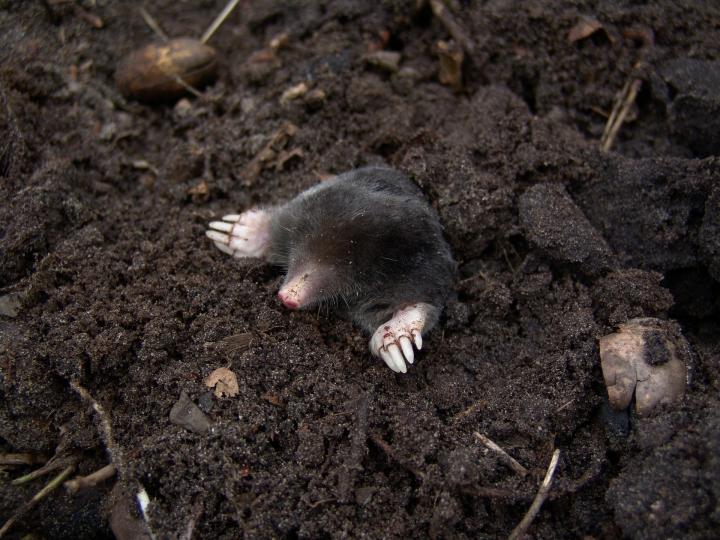 | 7. MOLES
Borrowing moles create ridges in the lawn which can damage plant roots. While grubs make up a portion of a mole’s diet, eliminating grubs doesn’t necessary eliminate moles.
There are really no habitat modifications to address mole problems. The only humane and effective way to eliminate moles in the lawn is traps. Even then, other moles could move into your yard. There are also baits for mole runs, but we would prefer to avoid this option. Placing ultrasonic devices or noisemakers such as spinning daisies near the runs is also helpful. | 8. DISEASES AND MOLD
There are some diseases that can infect lawns. Rust is probably the most common lawn disease which turns your grass orange or rust-colored, especially Kentucky bluegrass and perennial rye grass. A rusty powder that rubs off on your shoes in late summer or early fall is “lawn rust.”
For rust and most diseases, the solution is to simply change the way you care for your lawn. Mow at the correct height, fertilize appropriately, aerate compacted soil, irrigate properly (don’t overwater, water early in the day), and also buy disease-resistant grass seeds if available. Also, get a soil pH test each year to make sure you have the right levels of phosphorus and potassium, and the other nutrients that your grass needs.
Applying fungicides (which are pesticides that control fungal disease) is rarely warranted in a home lawn. A fungicide is meant to be preventative, so it’s too late for a fungicide once the grass is brown. It’s better to change the way you care for a lawn.
Similarly, if you see mushrooms after a rain, don’t worry. They will disappear as the soil dries up. If the mushrooms form a circle, it’s called a fairy ring. This means there is underground fungi. Again, there’s nothing to be concerned about. With drier weather, mowing, and light fertilization, it will disappear. If they persist, you can treat them as a bare spot (see #10 below).
If you encounter a slimey, colorful patch coating your grass, that’s slime mold. Just wait for the weather to dry up and the mold will turn grey and dry up, too. You can probably mow them off. Don’t add water with a hose. Don’t add chemicals. Raking could help speed up the drying and introduce some air to the lawn. | 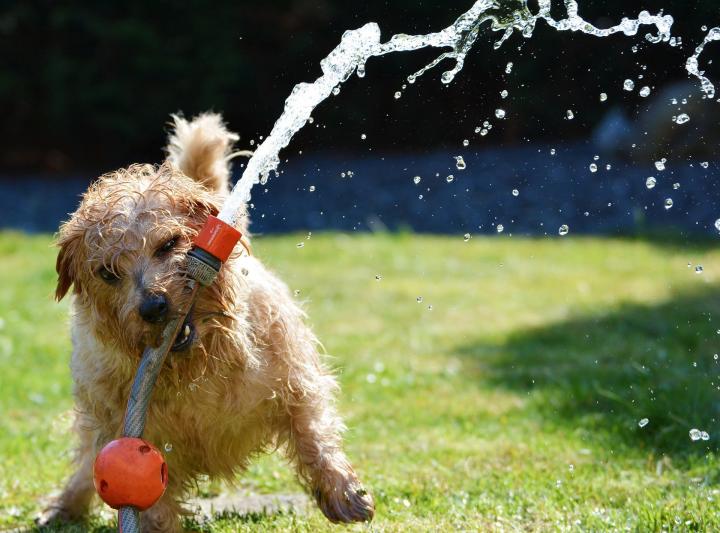 | 9. PET URINE SPOTS
Cat and dog urine contains damaging amounts of nitrogen, which can cause your lawn to brown. First, try to keep your pets off that part of the lawn. If you catch the pet urinating on the plants, you may be able to reduce the damage by watering the area. Or, dig up the spot (and several inches of lawn around the spot). Lightly till. Layer in loose topsoil (about .25 to .5 inch), reseed, and irrigate. Consider treating with a starter fertilizer. | 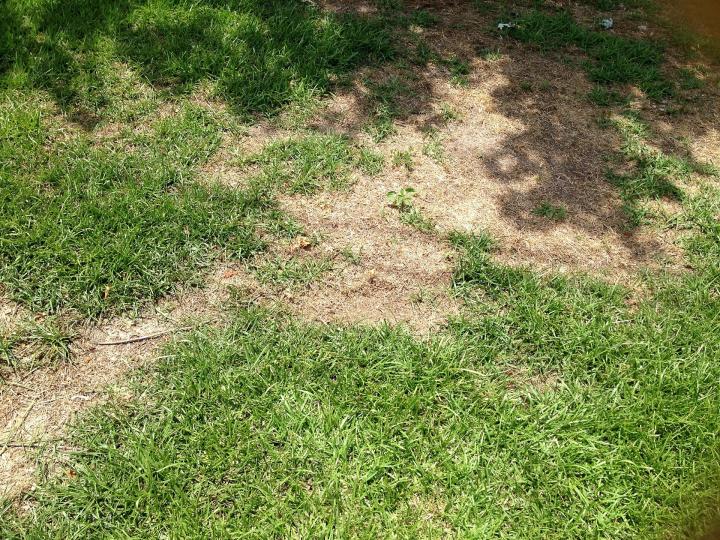 | 10. BARE SPOTS AND THIN LAWN
If your lawn seems very thin and neglected or has suffered from drought, it may need rejuvenation. This assumes you’ll provide good follow-up lawn care afterwards in terms of mowing, irrigation, and fertilizing.
Here are several options: - Thin Lawn? Overseed. If your lawn is established but thin and sparse, first check two things: 1) Are you using the right grass seed for your yard? 2) Test your yard’s pH levels and adjust as needed. Then, aerify the lawn. Mow the grass to a height of 1 to 1.5 inches, apply starter fertilizer, sow the seed, and gently rake to cover. Keep the lawn moist until seedlings are established, then water as needed.
- Bald Spots? Reseed. If you have a fairly robust lawn with bare or bald spots, you can fill in the bare areas. Dig up the spot (and several inches of lawn around the spot). Lightly till. Layer in loose topsoil (about .25 to .5 inch), reseed, and irrigate. Consider treating with a starter fertilizer.
- A Lawn of Weeds? Consider a complete lawn renovation. If you’re down to 30 to 40% grass and the rest weeds, consider starting over. This requires removing all the vegetation. If you use a non-selective herbicide, wait several weeks before seeding. If the soil is not compacted and there is no thatch, use an aerifier or a power rake set to cut ⅛ to ¼ inch into the soil. However, if the soil is compacted, till to a depth of 4 inches and let the soil settle for a week or two before seeding. On lawns with a lot of thatch, use a power rake and remove the thatch as you pull it up. Seed in the fall.
| 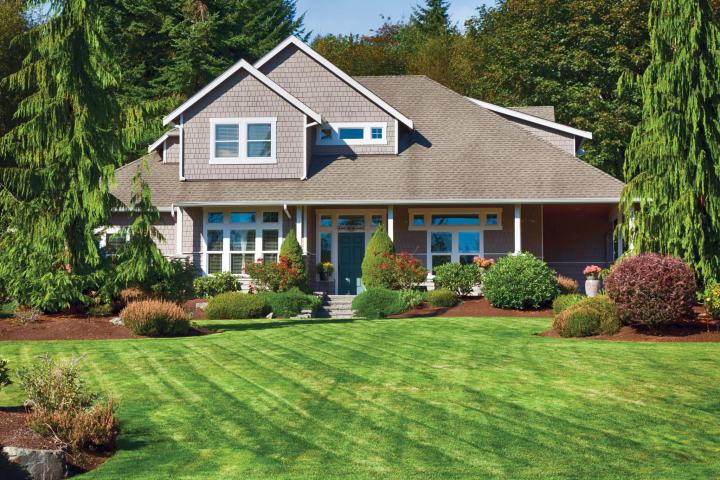 | | Credit: A Kurtz/Getty Images | 10 LAWN CARE MAINTENANCE TIPS
While we assume you are on this page because you have a lawn problem and we hope the above solutions helped. However, the best way to prevent problems is proper lawn care. Do you know what kind of grass seed is planted in your yard? Are you mowing, irrigating, and fertilizing correctly, based on your grass type? Check our 10 lawn care tips: - Keep weeds seeds out of your yard. Purchase weed-free mulch, compost, topsoil, and grass seed. Clean equipment after working in an area with lots of weeds.
- Test your soil before you select seeds or fertilize: The pH balance should be 7.0 or more—6.2 to 6.7 puts your lawn at risk of fungal diseases. If the pH is too low, correct it with liming, best done in the fall. Fertilize based on the nitrogen (N) needs of the grass.
- Select the right grass for your area, and use high-quality seed. With grass seed, you get what you pay for. Seed in late summer to early fall.
- Prepare a good seed bed. If the area is contaminated with perennial weeds, then you may need to use herbicide to clear the land to breakup those underground tubers and rhizomes.
- Mow high: As a rule, set your mower to 3 inches. This encourages deep roots. Most people mow too short which reduces the grasses’ ability to produce food via photosynthesis and invites weeds to move in.
- Mow frequently: Cut off any weed seeds before they mature by mowing regularly. However, never remove more than one-third of the grass leaf in a single mowing (called the “one-third” rule) or you reduce root growth. If your mower is set at 3 inches and you follow the one-third rule, you should mow before your lawn is 4.5 inches high. Typically, this is once a week during the growing season.
- Mow with a sharp blade. Sharpen 2 to 3 times a year.
- Leave grass clippings on the lawn as a natural fertilizer. (However, do break up clumps if needed; rake and mow over a second time.)
- Fertilize, at minimum, in early autumn. Apply 1 pound of actual N per 1,000 square feet in September. If you want a robust lawn AND have lawn irrigation, you can fertilize in the late spring and summer, too. Never fertilize in early spring as this stimulates leaf growth at expense of root growth.
- Don’t over-water. Make the lawn seek its own source of water, building longer and sturdier roots. Your lawn’s total water needs are about 1 to 1.5 inch a week. Take rainfall into account. Avoid short, frequent watering (sips) which promote a weak root system. Water thoroughly and deeply once a week to encourage the grass’s root system to go deeper, making the whole lawn more hardy and heat tolerant.
| |
|
| |












No comments:
Post a Comment